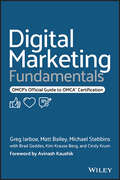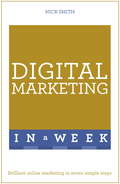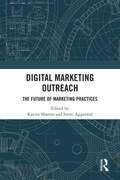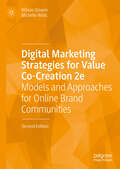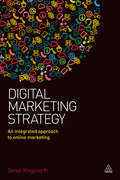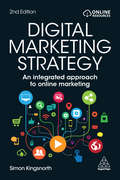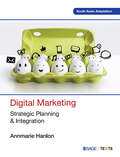- Table View
- List View
Digital Marketing Fundamentals: From Strategy to ROI (Routledge-Noordhoff International Editions)
by Mike Berry Marjolein Visser Berend SikkengaDigital Marketing Fundamentals is the first fully-fledged textbook on digital marketing that covers the entire marketing process. Both the scientific theory behind digital marketing as well as techniques and media are discussed. Digital Marketing Fundamentals is easy to read and contains many International examples and cases. The Dutch version of this book (Basisboek Online Marketing) has become a standard issue in The Netherlands. In this book, all relevant aspects of digital marketing are addressed: strategic aspects, market research, product development and realisation, branding, customer acquisition, customer loyalty and order processing. The book also discusses effective websites and apps, digital analytics and planning and organisation. The application of social media and mobile communication is seamlessly integrated into the topics. Digital Marketing Fundamentals is very suitable for commercial and management courses in Higher Education and also for professionals active in digital marketing.
Digital Marketing Fundamentals: From Strategy to ROI (Routledge-Noordhoff International Editions)
by Mike Berry Marjolein VisserDigital Marketing Fundamentals covers the entire marketing process. The academic theory behind Digital Marketing as well as techniques and media are discussed. Digital Marketing Fundamentals is easy-to-read and contains many international examples and cases. The Dutch version of this book (Basisboek Online Marketing) has become a standard issue in The Netherlands. In this book, all relevant aspects of Digital Marketing are addressed: digital transformation, strategy and business models, online customer behaviour and learning to understand the customer, online branding, customer acquisition and customer engagement, facilitating online purchases and setting up digital services. The book addresses step-by-step the role of Digital Marketing in each phase of the customer cycle: from the inspiration phase and research phase to the maintenance and replacement phase. Designing effective websites and apps, digital analytics and experimentation and planning and organization are also discussed. The book gives the reader an integrated basis with which they can respond to new trends and techniques in the future.Digital Marketing Fundamentals is suitable for commercial and management courses in Higher Education including Universities and Business Schools and also for professionals working in Digital Marketing.
Digital Marketing Fundamentals: OMCP's Official Guide to OMCA Certification
by Greg Jarboe Matt Bailey Michael StebbinsPrepare for the OMCP certification exam and expand your digital marketing skillset Courses relying on the OMCP Digital Marketing Certification standards attract over 70,000 students at 900 universities around the world each year. This challenging curriculum requires strong command of content marketing, conversion rate optimization, and other digital marketing competencies in high market demand. In Digital Marketing Fundamentals, veteran digital media and marketing experts Greg Jarboe, Michael Stebbins, and Matt Bailey deliver an essential and accessible roadmap to completing the highly sought-after OMCP Digital Marketing Certification. You’ll explore topics like digital analytics, social media marketing, and search engine optimization with the help of industry-leading authors and members of the OMCP Standards Committee. In the book, you’ll also find: Full discussions of paid search marketing, email marketing, and marketing to mobile device users Exacting and focused instruction on all the competencies tested by the OMCP exam Accessible content suitable for experienced digital marketers looking for a new certification to boost their career, as well as novice practitioners trying to expand their skillsetPerfect for aspiring and practicing digital marketers, Digital Marketing Fundamentals also belongs in the libraries of entrepreneurs, solopreneurs, and other small- and medium-sized business leaders looking for a starting point into the critical world of digital marketing.
Digital Marketing In A Week: Brilliant Online Marketing In Seven Simple Steps
by Nick SmithDigital Marketing In A Week is a simple and straightforward guide to brilliant digital marketing, giving you everything you need to know in just seven short chapters. From social marketing and search engine optimization, to 'paid' advertising, mobile marketing and creating the perfect website for driving sales, you'll discover the perfect toolkit to drive your successful digital marketing.This book introduces you to the main themes and ideas of digital marketing, giving you a knowledge and understanding of the key concepts, together with practical and thought-provoking exercises. Whether you choose to read it in a week or in a single sitting, NLP In A Week is your fastest route to success:- Sunday: Building the ultimate sales website- Monday: SEO: The backbone of any digital marketing strategy- Tuesday: Social media marketing madness- Wednesday: Pay per click (PPC) simplified and explained- Thursday: Mobile optimization and getting mobile users- Friday: Email marketing - why you should do it no matter what- Saturday: Other marketing tricks and tips in the modern worldABOUT THE SERIESIn A Week books are for managers, leaders, and business executives who want to succeed at work. From negotiating and content marketing to finance and social media, the In A Week series covers the business topics that really matter and that will help you make a difference today. Written in straightforward English, each book is structured as a seven-day course so that with just a little work each day, you will quickly master the subject. In a fast-changing world, this series enables readers not just to get up to speed, but to get ahead.
Digital Marketing Outreach: The Future of Marketing Practices
by Kavita Sharma Swati AggarwalThis book studies the use of digital marketing across the economic, social, and political sectors of India. It looks at diverse areas of business and non-business activities involving the use of digital platforms to augment marketing initiatives and improve reach, sales, and social media engagement. The volume analyses various themes including viral marketing, influencer marketing, webrooming behaviour, online impulse buying, telemedicine, social media advertising, and app-based cab services. It examines the role of digital marketing in creating a positive and favorable brand image for organisations by advertising their social responsiveness on social media and studies the influence of political brand value on social media activities. The authors also provide insight into changing trends within consumer behaviour, reflect on future challenges within the field, and highlight areas of growth. An important contribution to the study of new and emerging marketing practices, the book will be indispensable for students, researchers and teachers of communication, marketing, brand management, social media marketing, advertising, e-business, digital humanities, and consumer behaviour.
Digital Marketing Strategies for Value Co-Creation 2e: Models and Approaches for Online Brand Communities
by Wilson Ozuem Michelle WillisAmidst growing conceptual developments in the areas of value co-creation and digital marketing, the importance of Online Brand Communities (OBCs) has emerged to reinforce strategies. This book provides an introduction to a range of broad and debatable conceptual perspectives and mechanisms on the subject of OBC. Focusing on contemporary digital marketing issues, it offers a comprehensive examination of consumers’ response to active engagement in such communities. Building on the very successful original publication, this thoroughly revised second edition includes two new chapters on data-driven segmentation and artificial intelligence and customer engagement. The book balances theory with practical approaches and gives serious treatment to an important area of digital marketing strategy, providing an important resource for scholars, students and practitioners.
Digital Marketing Strategies for Value Co-creation: Models and Approaches for Online Brand Communities
by Wilson Ozuem Michelle WillisOnline brand communities (OBCs) are hugely important in the development of marketing strategy, but it is unclear how marketers can effectively utilise these platforms to enhance and develop consumer engagement. For an online brand community to be successful, it should allow members to feel a connection to the brand and with other members while forming a disconnection from those not belonging to the community. It should also have rituals and traditions that join members together over a revered commonality, and moral responsibility in contributing to the community. Indeed, brands play active roles in securing degrees of activity in OBCs’ through content that offers members the quality of engagement they seek. This book focuses on contemporary digital marketing issues in OBCs, offering a comprehensive examination of consumers’ response to active engagement in such communities. It discusses how brands can tap into the various levels of participation, engagement and online conversations in the development of marketing strategy and ultimately examines how an online brand community strengthens value co-creation. Balancing theory with practical approaches, this book gives serious treatment to an important yet until now overlooked area of digital marketing strategy, providing an important resource for scholars, students and practitioners.
Digital Marketing Strategy: An Integrated Approach to Online Marketing
by Simon KingsnorthThe modern marketer needs to learn how to employ strategic thinking alongside the use of digital media to deliver measurable and accountable business success. Digital Marketing Strategy covers the essential elements of achieving exactly this by guiding you through every step of creating your perfect digital marketing strategy. It contains analysis of the essential techniques and platforms of digital marketing including social media, content marketing, SEO, user experience, personalization, display advertising and CRM, as well as the broader aspects of implementation including planning, integration with overall company aims and presenting to decision makers.Simon Kingsnorth brings digital marketing strategy to life through best practice case studies, illustrations, checklists and summaries, to give you insightful and practical guidance. Rather than presenting a restrictive 'one size fits all' model, this book gives you the tools to tailor-make your own strategy according to your unique business needs and demonstrates how an integrated and holistic approach to marketing leads to greater success.
Digital Marketing Strategy: An Integrated Approach to Online Marketing
by Simon KingsnorthEffectively select, align and manage digital channels and operations using this second edition of the bestselling guide, Digital Marketing Strategy. This accessible, step-by-step framework enables the planning, integration and measurement of each digital platform and technique, all tailored to achieve overarching business objectives. Ranging from social media, SEO, content marketing and user experience, to customer loyalty, automation and personalization, this edition features cutting edge updates on marketing automation, messaging and email, online and offline integration, the power of technologies such as AI, plus new data protection and privacy strategies. Accompanied by downloadable templates and resources, Digital Marketing Strategy is an ideal road map for any marketer to streamline a digital marketing strategy for measurable, optimized results. Online resources include lecture slides, activity sheets, practical implementation guides and templates, which will be regularly updated to equip readers as digital marketing continues to evolve.
Digital Marketing Strategy: An Integrated Approach to Online Marketing
by Simon KingsnorthBuild an effective and practical digital marketing strategy with this bestselling guide, covering everything from automation and analytics to integrating AI. Digital Marketing Strategy is a global bestseller, and a one-stop guide to structuring and building a more strategic approach to digital marketing. Now fully updated, this third edition covers the integration of AI in marketing, e-commerce, marketing automation, affiliate marketing and how to use digital analytical tools, plus new strategies for the latest cookie changes and privacy protection. Digital Marketing Strategy will show you how to effectively select, align and manage digital channels and operations, to streamline a successful digital marketing strategy for measurable, optimized results. Recommended by the Chartered Institute of Marketing (CIM), it is supported by real-world case studies from the likes of Coca-Cola, Spotify, Airbnb, Adidas and Hostelworld as well as checklists, key terms and insights from leading industry practitioners to help you develop your own digital marketing strategy. This book is an invaluable guide for both digital marketing students and entry-level to mid-management marketing professionals. Accompanying online resources consist of practical implementation guides spanning SEO, paid-search, email, lead-generation, as well as presentation slides and activity sheets.
Digital Marketing Technologies
by Hashem Aghazadeh Mozhde KhoshnevisThis book argues that digital marketing should benefit from emerging technologies to result in sustainable competitive values for businesses in both the digital and physical worlds. It not only explores digital marketing fundamentals, analysis, strategy, practices, and implementation but also explains the applications and relationships of marketing technologies (martechs) with digital marketing; as well as offers several real cases of practicing marketing technologies. It carefully describes how modern businesses offer their value propositions both digitally and physically applying emerging technologies specifically marketing technologies (martechs) and how consumers are using these new technologies particularly artificial intelligence (ChatGPT/ OpenAI). It investigates why consumers are so intrigued and interested in digital relationships, interaction, and shopping experiences. It critically examines and argues that digital marketing has become popular among businesses as they areattempting to serve their customers better by taking advantage of using digital marketing technologies (marketchs).
Digital Marketing at HBS Online
by Rajiv Lal Sunil GuptaIn July 2020, the management team of Harvard Business School Online (HBS Online) had to decide how to allocate its marketing budget for fiscal year 2021 between various digital channels and its portfolio of courses. Since its launch in 2014, HBS Online had grown to almost $60 million in revenue and there were concerns about its potential overlap with other HBS programs such as executive education and Harvard Business Publishing. Growth of HBS Online also raised questions about potential brand dilution of HBS.
Digital Marketing in Practice: Design, Implement and Measure Effective Campaigns
by Hanne Knight Lizette VorsterLearn how to create effective digital marketing campaigns, analyze competitor behaviour and conduct digital marketing in a responsible and accountable way with this real-life focussed and streamlined textbook.Digital Marketing in Practice balances step-by-step practical coverage with academic theoretical context throughout to offer a definitive and easy-to-understand resource. Exploring key definitions and best-practice for tools, channels and platforms including SEO, social media marketing, email marketing and online advertising, it shows how to create plans and set objectives, design digital marketing campaigns and evaluate their success for improvement.Digital Marketing in Practice also describes how to incorporate accountability, inclusivity and meaningful sustainability messaging. Featuring interviews with industry professionals and case study examples from a range of brands including Nielsen and the Met Office, it also contains how-to guides, check lists and critical thought pieces.Supported by online resources consisting of lecture slides, self-test questions, group activities, worksheets, additional interactive case studies and further resource links, it is an indispensable text to equip students with the tools to develop and implement successful digital marketing.
Digital Marketing in Sports: Global Perspectives (World Association for Sport Management Series)
by James J. Zhang Brandon MastromartinoThis book examines how the sport industry is adapting to the needs of the digital-first global economy. Focusing on digital techniques in sport marketing, this volume explores new and emerging technologies and considers how they can help to build commercially successful and sustainable sport business. Featuring the work of sport business and management researchers from around the world, the book shines new light on key aspects of sport marketing such as brand development, consumer behavior and marketing communications. Illustrated with informative figures throughout, it presents cutting-edge case studies and new research on digital marketing covering topics including the metaverse and video games; esports; athlete endorsement; digital immersion; social media; equity crowdfunding; digital fandom and dark market brands. Global in scope, this book is fascinating reading for any student, researcher or industry professional looking to deepen their understanding of digital marketing in the context of the global sport industry.
Digital Marketing in the Automotive Electronics Industry: Redefining Customer Experience through Digital Customer Engagement (Management for Professionals)
by Uli Schneider Jürgen HoikaThe book complements the current body of knowledge in business-to-business marketing with the experience of many professionals ranging from marketers to top management of a leading automotive semiconductor supplier worldwide. It presents unique and adaptable practical concepts, case studies, and tested models from practice. The book operationalizes the theory of approaches such as omni-channel marketing, and target driven performance marketing into practical and actionable approaches in large B2B companies in automotive sectors. The change management nature of the digital transformation of marketing is a common thread throughout the book and the experience of more than 10 practitioners, allowing readers to relate the content directly to their own business reality.
Digital Marketing: A Practical Approach
by Alan CharlesworthDigital Marketing: A Practical Approach 2nd Edition is a step-by-step guide to marketing using the Internet. Concentrating on the operational and functional aspects of this dynamic subject, the book is packed with tactical advice and real-life examples from those leading the field to help you succeed. Written as an accessible guide to equip you for the digital element of any contemporary marketing role, Digital Marketing covers all the key topics including search engine optimization and social media marketing. With real-world case studies to illustrate digital marketing in practice and exercises to help you analyse, plan and execute effective strategies within the workplace, this practical resource will prepare you to undertake digital marketing across a variety of organizations. More than just a book, this complete package features an associated website at AlanCharlesworth.eu/DigitalMarketing which hosts the case studies for the book, offers further tips and advice and provides access to a wealth of extra material such as up-to-date references and web links. This new, second edition builds on the first edition's success by addressing the key recent developments in digital marketing including an expanded section on social media marketing and an appreciation of the impact of mobile devices. Moreover, it's been thoroughly updated throughout, with brand new cases and examples with an international range, all of which encourage the reader to quickly learn the practical applicability of the theory and practice of emarketing.
Digital Marketing: A Practical Approach
by Alan CharlesworthAs in the previous editions of this book, whilst strategic issues are included where appropriate, by concentrating on the operational and functional aspects of this dynamic subject, Digital Marketing: A Practical Approach provides a step-by-step guide to implementing the key aspects of online marketing. Similarly, although primarily aimed at an academic market, the practical – rather than purely theoretical – nature of the book means that it will be equally useful in both training and self-learning scenarios. After reading this book - and completing the exercises within it - the reader will be equipped to undertake any digital marketing role within a variety of organizations. The practical case-study exercises - based on theory and recognized good practice - will ensure that readers will be able to analyse situations within the work place, identify the most appropriate course of action and implement the strategies and tactics that will help the organization meet its online objectives. A key aspect to this digital marketing book is the use of a number of bespoke case studies that are designed to make clear how the impact of each online application varies between organizations and markets. For each section of every chapter there is a case study question that is pertinent to that subject - though readers are welcome to switch case studies for each question if they so wish, or even substitute their own organization. This makes the book an excellent text for work-based learning programmes such as Degree Apprenticeships. As the subject has evolved in recent years, so too has the structure of the third edition of this book. The book is now in two distinct parts. Part I considers the environment in which digital marketing is practised, digital buyer behaviour and has a chapter that includes sections covering strategic digital issues such as content marketing, attribution, influencers and digital marketing objectives. Part II replicates the successful structure of the first two editions of the book by having chapters devoted to the key elements of operational digital marketing. Essential updates made necessary by both technology and consumer behaviour are made to all elements, but specifically to programmatic advertising and marketing on social media. There is also the addition of a chapter devoted to e-metrics and online analytics. Online support and subject updates that both complement and enhance each chapter’s content can be found on the author’s website at AlanCharlesworth.com/DigitalMarketing.
Digital Marketing: A Practical Approach
by Alan CharlesworthDigital Marketing: A Practical Approach provides a step-by-step and comprehensive guide to implementing the key aspects of digital marketing. Building on the previous editions, this fully updated fourth edition takes an approach that prepares students for an active role in digital marketing. As well as topic-based exercises, the text also includes practical case-study exercises – based on theory and recognized good practice – which will ensure that readers will be able to analyse situations within the work place, identify the most appropriate course of action and implement the strategies and tactics that will help the organization meet its online objectives. Key updates to the new edition include: o The role of the digital influencer. o Direct to Consumer (DTC) and omni-channel retailing. o Individuals’ privacy and the role of organizations in gathering and storage of their personal data. o Ethical aspects of digital marketing and its impact on the environment. o SEO and Google’s development of the ‘zero click’. o Online ad fraud. o Updated online resources available via the author’s own site. This essential text equips advanced undergraduate, postgraduate and executive education students with the tools to undertake any digital marketing role within a variety of organizations. Comprehensive support material available online for both students and instructors includes links to articles and opinion pieces, PowerPoint lecturer slides and questions based on the chapter material.
Digital Marketing: A Practical Approach (Second Edition)
by Alan CharlesworthDigital Marketing: A Practical Approach 2nd Edition is a step-by-step guide to marketing using the Internet. Concentrating on the operational and functional aspects of this dynamic subject, the book is packed with tactical advice and real-life examples from those leading the field to help you succeed. Written as an accessible guide to equip you for the digital element of any contemporary marketing role, Digital Marketing covers all the key topics including search engine optimization and social media marketing. With real-world case studies to illustrate digital marketing in practice and exercises to help you analyse, plan and execute effective strategies within the workplace, this practical resource will prepare you to undertake digital marketing across a variety of organizations. This new, second edition builds on the first edition's success by addressing the key recent developments in digital marketing including an expanded section on social media marketing and an appreciation of the impact of mobile devices. Moreover, it's been thoroughly updated throughout, with brand new cases and examples with an international range, all of which encourage the reader to quickly learn the practical applicability of the theory and practice of emarketing.
Digital Marketing: Analyzing its Transversal Impact (Advances In Marketing, Customer Relationship Management, And E-services Ser.)
by José Duarte Santos Paulo Botelho Pires Inês Veiga PereiraDigital marketing is not a new concept, it is not a trend, and it is not a fad either. Digital marketing has existed for over twenty years and is currently applied in all areas and marketing activities. For this reason, it is necessary to know the changes it has brought about, both in the theoretical framework, so that it can be taught, and from an empirical perspective, so that it can be applied in real contexts. The changes have been profound and far-reaching.This work addresses this theme, aiming to analyse the transversal impact of the digital in the different marketing sectors, describing the profound changes that the digital has provoked in the main marketing activities and their sectors, also referring to the current practices in use in each included topic. It begins by looking at the classic marketing topics, opening with an analysis of the impact that digital has had and is having on the marketing strategy of organisations, moving on to the study of consumer behaviour in an era of continuous use of electronic devices. This is followed by a new topic which is marketing research and data analysis, in a context where managers now have, more data, information and knowledge about the organisation, competitors, consumers and the wider environment than ever before. Marketing themes were also identified that have been significantly changed with digital. Communication is another of the themes of reference, with profound changes in recent times, followed by management of sales teams, supply chain management, relationship marketing, and internal marketing. The last chapters are also relevant contributions, being dedicated to marketing sectors: services, B2B marketing, internationalisation, politics, tourism, and NGOs.
Digital Marketing: Integrating Strategy and Tactics with Values, A Guidebook for Executives, Managers, and Students
by Ira Kaufman Chris HortonDigital Marketing: Integrating Strategy and Tactics with Values is an easy-to-understand guidebook that draws on the latest digital tactics and strategic insights to help organizations generate sustainable growth through digital integration. It provides a roadmap to adopt a digital mindset, incorporate digital trends strategically, and integrate the most effective digital tactics and tools with core values to achieve competitive advantage. Bringing the reader through its five-step Path to Digital Integration (Mindset, Model, Strategy, Implementation, and Sustainability), Digital Marketing seeks to Outline the key drivers of change and leading digital marketing trends executives need to understand and incorporate to drive business opportunity. Evaluate the digital channels and technologies management teams can leverage to execute a successful Integrated Digital Marketing strategy. This includes insight into the latest digital tactics (website, social, mobile, search, content, and email marketing; data analytics) and social tools (Facebook, Twitter, YouTube, LinkedIn, Instagram, Pinterest, and Google Plus). Discover the impact of digital transformation on the organization, from the effect of digital tactics on the customer experience (CX) to the value of integrating internal digital strategies to facilitate collaboration and innovation. Guide aspiring leaders on how to combine core values and business goals with progressive digital strategies, tactics, and tools to generate sustainable outcomes for all stakeholders. This interactive guidebook provides a truly Connected Digital Experience (CDE): the Zappar augmented reality mobile app allows the reader to activate the "Discover More" and "Play Video" icons found throughout the book, instantly connecting the reader, via their mobile device, to additional content housed on our companion website, Digital Marketing Resource Center (www.dmresourcecenter.org). "Play Video" icons incorporate point-in-time video commenting solution Vusay to enable interactive social conversations around each video. Digital Marketing is the ideal guide for aspiring leaders - executives, instructors, owners, entrepreneurs, managers, students - at all stages of digital literacy.
Digital Marketing: Strategic Planning & Integration
by Annmarie HanlonCovering all aspects of digital marketing planning, the book aims to provide a roadmap for a digital marketing journey. An unbiased approach to the latest digital marketing models, offering students and practitioners a range of tools to implement in their digital marketing planning and strategy. Covering all aspects of digital marketing planning, the book aims to provide a roadmap for a digital marketing journey. This book has been structured to map the development of a digital marketing plan and concludes with a ready-made plan template to download and adapt. In addition, the content is supported by case examples from real-world organizations, and a number of pedagogical features throughout the chapters. The book is suitable for digital and e-marketing courses as well as professional courses for anyone interested in gaining a holistic understanding of digital marketing. Key Features: • Smartphone sixty seconds features in every chapter to evaluate influencers in relation to the topic covered • Digital tool boxes introduce professional tools • Ethical insights provide a reflective and challenging look at social issues and the negative sides of marketing.
Digital Marketing: Strategic Planning & Integration
by Annmarie HanlonAn unbiased, balanced guide to all aspects of digital marketing, from social media, mobile and VR marketing to objectives, metrics and analytics. Covering all aspects of digital marketing planning and the latest models, the book also offers a range of tools to help implement your own digital marketing plans and strategies. The second edition has been expanded to include new discussions and research on areas including digital privacy, types of influencers, social listening and the gig economy. Key features: Supported by case examples from 28 global companies and brands including IKEA, Uber, Klarna and TikTok. A brand-new case study on Strava runs throughout the book to help you apply what you’ve learnt to real-world scenarios. ‘Ethical Insight’ boxes provide a reflective and challenging look at social issues and the negative side of marketing. ‘Digital Tool’ boxes introduce professional tools, such as ‘Spot the Troll’, Hootsuite and Padlet. The ‘Smartphone Sixty Seconds’ feature provides super-quick online activities using needing only your phone. Includes a new ‘Journal of Note’ feature in each chapter, to direct you to a key source of further reading. Worked digital marketing plan. Complimented by online resources, including PowerPoint slides, and Instructor’s Manual, quizzes, recommended video links and free SAGE Journal articles. Suitable for digital and e-marketing courses at all levels, as well as professional courses for anyone interested in gaining a holistic understanding of digital marketing.
Digital Marketing: Strategic Planning & Integration
by Annmarie HanlonAn unbiased, balanced guide to all aspects of digital marketing, from social media, mobile and VR marketing to objectives, metrics and analytics. Covering all aspects of digital marketing planning and the latest models, the book also offers a range of tools to help implement your own digital marketing plans and strategies. The second edition has been expanded to include new discussions and research on areas including digital privacy, types of influencers, social listening and the gig economy. Key features: Supported by case examples from 28 global companies and brands including IKEA, Uber, Klarna and TikTok. A brand-new case study on Strava runs throughout the book to help you apply what you’ve learnt to real-world scenarios. ‘Ethical Insight’ boxes provide a reflective and challenging look at social issues and the negative side of marketing. ‘Digital Tool’ boxes introduce professional tools, such as ‘Spot the Troll’, Hootsuite and Padlet. The ‘Smartphone Sixty Seconds’ feature provides super-quick online activities using needing only your phone. Includes a new ‘Journal of Note’ feature in each chapter, to direct you to a key source of further reading. Worked digital marketing plan. Complimented by online resources, including PowerPoint slides, and Instructor’s Manual, quizzes, recommended video links and free SAGE Journal articles. Suitable for digital and e-marketing courses at all levels, as well as professional courses for anyone interested in gaining a holistic understanding of digital marketing.
Digital Marketing: Strategic Planning & Integration (Quick Win Ser.)
by Annmarie HanlonAn unbiased approach to the latest digital marketing models, offering students and practitioners a range of tools to implement in their digital marketing planning and strategy. Covering all aspects of digital marketing planning, and the latest digital marketing models, the book aims to provide a roadmap for a digital marketing journey. As such, its structure maps against the development of a digital marketing plan and concludes with a ready-made digital marketing plan template to download and adapt. In addition to this, the content is supported by case examples from real-world organizations, and a number of features throughout the chapters: Smartphone sixty seconds features in every chapter, to evaluate influencers in relation to the topic covered. Digital tool boxes introduce professional tools (for example how Google shares its aggregate data to inform marketers about shopping insights, trends and benchmarks Ethical insights provide a reflective and challenging look at social issues and the negative sides to marketing. The book is complemented by online resources for both instructors and students, these include PowerPoint slides, an instructor’s guide, exercises and activities relating to each chapter, digital marketing planning documents, digital marketing model templates, quizzes, annotated recommended video links, links to free online tools and SAGE journal article recommendations. Suitable for digital and e-marketing courses on marketing and advertising degrees as well as professional courses for anyone interested in gaining a holistic understanding of digital marketing.


